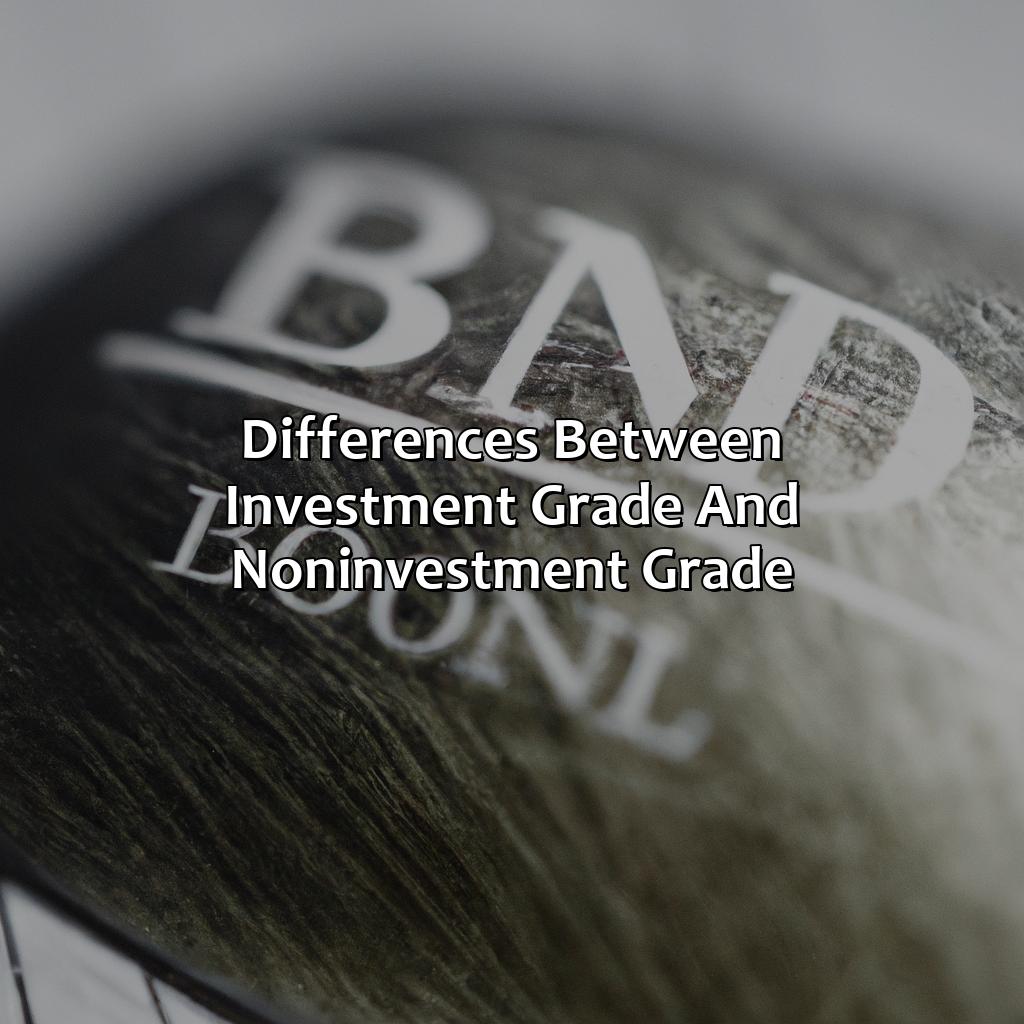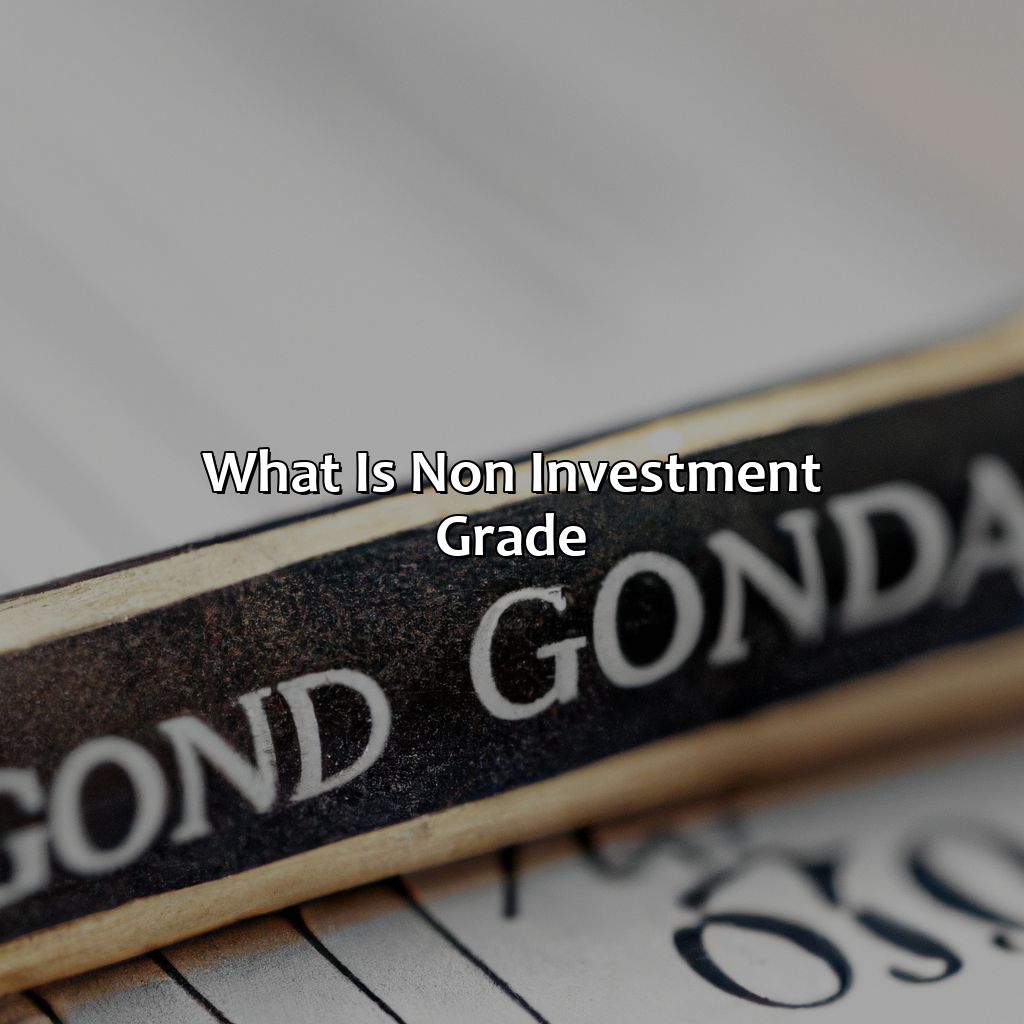What Is Non Investment Grade?
Key Takeaway:
- Non-investment grade refers to bonds that are rated below BBB- by credit rating agencies. These bonds are considered riskier investments due to their higher likelihood of default and therefore offer higher returns to investors.
- The credit ratings of non-investment grade bonds are based on factors such as the issuer’s financial stability, debt levels, and past payment history. A lower credit rating indicates a higher risk of default.
- Non-investment grade bonds have several characteristics, including a higher default rate, higher coupon yields, and less liquidity in the market compared to investment-grade bonds. These characteristics make non-investment grade bonds more suitable for experienced and risk-tolerant investors.
Are you wondering what non investment grade is and how it could impact your finances? Don’t worry, you’re not alone. In this article, we’ll explore non investment grade debt and what risks you face when making such investments. You’ll be able to make a more informed decision and understand the potential risks associated with this type of debt.
Non-Investment Grade
To comprehend non-investment grade, first delve into its definition. Credit ratings are pivotal in loan agreements, so comprehend how it influences non-investment grade assets. These bonds showcase certain features which emphasize the risk and rewards involved.

Image credits: retiregenz.com by Joel Jones
Definition of Non-Investment Grade
Non-Investment Grade, commonly known as junk bonds, is a type of bond with a credit rating of BB or below. These bonds have a higher risk of default and are issued by companies with lower creditworthiness. Non-Investment Grade bonds offer higher yields than Investment Grade bonds due to the higher risk involved.
Investors who are willing to take on more risk for potentially higher returns may consider investing in Non-Investment Grade bonds. However, it is essential to conduct thorough research into the issuing company’s financial health and debt obligations before investing. Potential investors must also consider credit ratings, interest rates, and economic conditions when making investment decisions relating to Non-Investment Grade bonds.
It is crucial to keep in mind that investing in Non-Investment Grade bonds carries a more significant level of risk than Investment Grade bonds. Although the potential rewards can be significant, investors need to be aware that there is always a possibility that they could lose their entire investment.
Don’t miss out on potential high returns by ignoring investment opportunities involving non-investment grade securities! With proper research and understanding of market conditions, these opportunities could lead to elevated wealth accumulation.
Credit ratings are like high school report cards, except instead of determining your popularity, they determine your financial stability.
Credit Ratings
Credit analysis is a vital tool for financial institutions to assess the creditworthiness of businesses, governments, or individuals who might require funding. Credit ratings serve as an indicator of the likelihood that an entity will default on their debt obligations. These ratings range from high to low and are assigned by independent credit rating agencies who use complex methodologies to evaluate all aspects of an entity’s financials and operations.
Non-investment grade refers to entities rated below BB- by Standard & Poor’s Global Ratings or below Ba3 by Moody’s Investors Service. Such ratings indicate higher risk of default, which results in higher borrowing costs. Non-investment grade entities include those with a weak or uncertain financial position, troubled operations, or unfavorable economic conditions.
It is worth noting that non-investment grade ratings can be volatile and subject to change based on market trends and other external factors. Furthermore, lower-rated entities often face challenges in accessing capital markets due to limited investor interest.
In one instance, a multinational corporation with non-investment grade ratings faced difficulties securing financing for a new product launch due to its perceived risk profile. The company had to approach alternative lenders willing to offer higher interest rates in exchange for taking on greater risk.
Non-Investment Grade Bonds: The bad boys of the bond world, they may be risky but they sure know how to have fun.
Characteristics of Non-Investment Grade Bonds
Non-investment grade bonds or high yield bonds are those that come with a higher risk of default than investment-grade securities. These bonds are issued by companies with a lower credit rating and therefore, come with a higher yield as compensation for the increased risk.
Non-investment grade bonds often have lower credit ratings due to their issuers’ financial instability or the characteristic nature of their business. These bonds can be difficult to resell and may have less liquidity in the secondary market, resulting in higher transaction costs.
Moreover, these bonds come with covenants that offer protection to bondholders. In case of credit deterioration, the covenants may increase security on collateral or restrict certain business activities related to debt repayment.
It is interesting to note that even though non-investment grade bonds carry a higher risk, they attract investors looking for potentially higher returns. According to Bloomberg, in 2020 alone, US companies sold over $446 billion worth of non-investment grade bonds at yields averaging 5.83%, which is significantly higher than investment-grade securities.
Why settle for investment grade when you can live dangerously with non-investment grade? It’s like choosing a mediocre rom-com over an action-packed thriller.
Differences Between Investment Grade and Non-Investment Grade
To get the gist of investment grade vs. non-investment grade, one needs to pay attention to risk and return, market impact, and investor base. Each of these have distinct answers that can explain why investing in non-investment grade bonds is more dangerous than investing in investment grade ones.

Image credits: retiregenz.com by David Woodhock
Risk and Return
When considering investments, it is important to understand the connection between risk and return. Investments that offer higher returns typically involve higher levels of risk. Investment grade securities are those deemed low risk and therefore have lower yields, while non-investment grade securities carry more risk and correspondingly offer higher yields.
Non-investment grade bonds, aka high yield bonds or junk bonds, are issued by companies with lower credit ratings who are viewed as less likely to repay debt. These types of bonds can offer high yields if investors are willing to take on additional risk. However, this means they are more susceptible to defaults and market fluctuations than investment-grade bonds.
The current market has seen an uptick in interest for non-investment grade securities due to their promising returns. But investors must carefully consider the risks associated with these products before investing their capital.
In 2015, a major beverage corporation issued $7 billion in non-investment grade bonds at a reduced interest rate compared to other issuers in the same category. Despite its strong brand name and revenue streams, investors had concerns about the corporation’s recent financial track record leading some analysts to question if the company could realistically pay back such a large sum of borrowed capital. In response, ratings agencies downgraded the company’s credit rating, making it even harder for them to borrow more money in the future without paying a significantly higher interest rate to bondholders.
Don’t panic if your investments are non-investment grade, just remember that sometimes even junk can be turned into treasure in the right market.
Market Impact
The Influence of Investment vs. Non-Investment Grade on the Market
Investment grade and non-investment grade securities carry distinct risks and rewards that have a significant impact on the market. Bonds or stocks that are deemed investment-grade typically carry low risk and provide modest returns, while non-investment grade securities offer high return potential with significant risk. The market impact of choosing one over the other is vast, as it can affect investors’ portfolios and influence market trends.
Understanding the differences between these two types of securities is essential for making informed investment decisions because they have varying degrees of credit quality and ability to repay debt obligations. Moreover, investment-grade investments may receive higher ratings from credit rating agencies, while non-investment grade offerings may experience more volatility in prices when business conditions change.
While investing in non-investment grade options may seem tempting due to the possibility of higher returns, investors must consider a plethora of factors before committing their money to such ventures. Factors like recession, default risk, creditworthiness could significantly impact returns.
A true fact about these two types of bonds is that rating agencies assess them by looking at corporate financial statements, economic indicators, industry trends etcetera. As per Fitch Ratings Inc., only about 20% of corporate bonds carry an investment-grade rating during any given year.
Investing: making rich people richer since forever.
Investor Base
Investors who engage in non-investment grade securities are often hedge funds, private equity firms, or distressed debt investors. Non-investment grade securities offer higher yields but carry higher credit risk. In contrast, investment-grade securities attract institutional investors, including mutual funds and insurance companies. The nature of the investor base is related to the product’s credit rating and default probability rather than a specific market category or industry.
Additionally, the investor base can vary depending on the issuer’s reputation and financial history. Established companies with a strong track record of generating cash flow generally attract wider participation from global investors across various industries. Similarly, smaller companies with less market presence usually have limited participation from relatively smaller-sized investors.
Pro Tip: Investors should pay attention to their portfolio’s allocation to investment-grade versus non-investment grade securities as it affects diversification and overall risk exposure.
Some Facts About What Is Non Investment Grade:
- ✅ Non investment grade, also known as high-yield or junk bonds, are issued by companies with poor credit ratings. (Source: Investopedia)
- ✅ These bonds offer higher interest rates as compensation for their higher risk of default. (Source: The Balance)
- ✅ Non investment grade bonds have historically had higher default rates compared to investment grade bonds. (Source: Fidelity Investments)
- ✅ Non investment grade bonds make up a smaller portion of the overall bond market, but have grown in popularity as investors search for higher yields. (Source: The Wall Street Journal)
- ✅ Investing in non investment grade bonds requires careful analysis and due diligence to minimize risk and maximize returns (Source: Forbes)
FAQs about What Is Non Investment Grade?
What is non investment grade?
Non investment grade, also known as high-yield, speculative or junk bonds, are fixed income securities that are not rated investment grade by credit rating agencies. These bonds have a higher risk of default and are issued by companies with weaker credit ratings.
How do non investment grade bonds differ from investment grade bonds?
Investment grade bonds have higher credit ratings and are issued by companies with stronger credit profiles. They are considered safer investments and have lower default rates than non investment grade bonds. Non investment grade bonds, on the other hand, offer higher returns but come with greater risk.
What are the risks of investing in non investment grade bonds?
The primary risk of investing in non investment grade bonds is default. Since these bonds are issued by companies with weaker credit ratings, the likelihood of default is higher. In addition, non investment grade bonds are more sensitive to changes in interest rates and economic conditions, which can affect their value and return.
What factors determine a bond’s credit rating?
Bond credit ratings are determined by credit rating agencies such as Moody’s, S&P, and Fitch. These agencies assess a bond issuer’s creditworthiness based on various factors, including financial strength, earnings stability, debt levels, and industry trends. The rating assigned to a bond reflects the agency’s assessment of the issuer’s ability to repay the bond’s principal and interest.
Can non investment grade bonds be a good investment?
Non investment grade bonds can offer higher returns than investment grade bonds, but they come with higher risk. As with any investment, it’s important to consider your personal risk tolerance and investment goals before deciding whether to invest in non investment grade bonds. It’s also important to carefully research the issuer and assess their creditworthiness before investing.
How can investors mitigate the risk of investing in non investment grade bonds?
Investors can mitigate the risk of investing in non investment grade bonds by diversifying their portfolio and investing in a range of bonds with varying credit ratings. It’s also important to carefully research the issuer and assess their creditworthiness before investing. In addition, investors can consider investing in professionally managed high-yield bond funds, which offer the potential for higher returns while spreading risk across multiple issuers.
